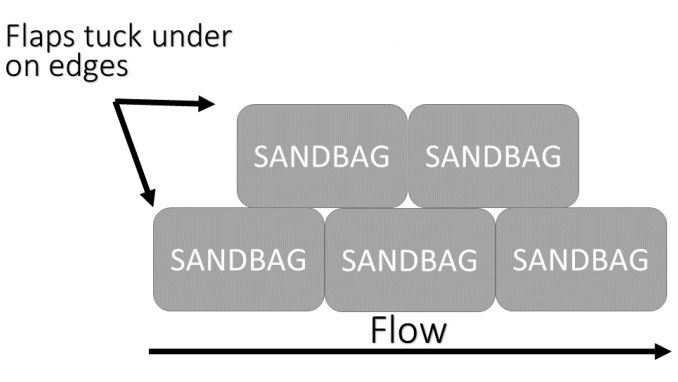Sandbags
FREE sandbags for residents
The City of Menlo Park offers sandbags to help residents prepare for heavy rainfall. Sandbags can be used to redirect and divert water away from your home or business. Residents and businesses are encouraged to reuse sandbags for future rain events.
Residents can pick up sand and empty bags at the following locations.
*Please remember to bring a shovel.
How to fill sandbags
The video above offers a step-by-step guide to filling and placing sandbags. Gloves are recommended to protect your hands.
Follow these steps to properly fill a sandbag:
- Grab one sandbag.
- Get a partner.
- Fill each bag to one-third to one-half full. This keeps the bag from getting too heavy and allows the bags to stack with a good seal.
- Tie the bag at the top so that bag will lay flat when put in place. A properly filled sandbag should weigh between 30-40 pounds.
- Remember not to overfill the bag or tie it too low. Overfilled bags and bags tied too low leave gaps in sandbag levee allowing water to seep through.
- After handling sandbags, wash your hands and face.
Sand bag placement

- Remove any debris from the area where bags will be placed.
- Fold the open end of the unfilled portion of the bag to form a triangle. If tied bags are used, flatten or flare the tied end.
- Place the partially-filled bags lengthwise and parallel to the direction of flow. The open end should face against the water flow.
- Tuck the flaps under, keep the unfilled portion under the weight of the sack.
- Place remaining bags on top, offsetting by one-half filled length of previous bag, and stamp into place to make a tight seal.
- Stagger the joint connections when multiple layers are necessary.
- For unsupported layers over three courses high, use the pyramid placing method.
Pyramid Placement is an option for anyone who wants to increase the height of sandbag protection. To do this method, follow these steps:
- Place sandbags to form a pyramid by alternating placing bags crosswise and lengthwise.
- Stamp each bag in place, overlap sacks, maintain staggered joint placement and tuck in any loose ends.

It's recommended to wrap the sandbag levee in plastic and place filled sandbags on plastic to weigh it down.
Sandbag reuse and disposal tips
Residents and businesses are encouraged to reuse clean sandbags or dispose of contaminated sandbags. Sandbags that did not come into contact with floodwaters can be safely reused or stored. At the end of the rainy season, residents can return their unused sand bags to the sand bag station at the corner of Burgess Drive and Alma Street.
Quick fact: During the early January 2023 series of storms, Public Works distributed more than 220 tons of sand, approximately 11,000 sandbags, for Menlo Park residents and businesses.
For sandbags that did not come into contact with floodwaters
- To prolong their life, store them in a dry place out of the sun.
- Covering or wrapping them in dark plastic sheeting (available from most hardware stores) can protect against UV rays.
- If your bags have deteriorated or started to leak, the sand can be placed into new bags or spread on landscape beds.
For sandbags that did contact floodwater
- Sandbags in contact with floodwaters may become contaminated by sewage, animal waste, oil, lawn chemicals or other hazardous chemicals.
- Wear gloves and a dust mask when handling potentially contaminated materials.
Disposal tips
- Do not place used sand in or near bodies of water, playgrounds, sandboxes or other areas of direct human contact.
- Do not dispose of any sand or full sandbags in your regular trash.
- Do not mix sandbags with yard debris for disposal. The sand is abrasive and damages equipment used to convert yard debris into mulch.
- Place the empty bags in your garbage bin; do not place the bags in your recycling bin.